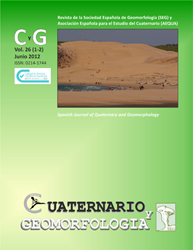Throughfall and stemflow in the San Salvador catchment, Central Spanish Pyrenees
Keywords:
interception, throughfall, stemflow, Pinus sylvestris, Fagus sylvatica, Quercus gr. faginea, Central PyreneesAbstract
Throughfall and stemflow have been studied in a forest-covered catchment in the Central Spanish Pyrenees. The San Salvador catchment (0,92 km2) is located in the Aísa Valley, in which trends in plant cover evolution show an increase of the presence of open and dense forests, after the abandonment of agricultural activities since the middle of the 20th Century. San Salvador catchment shows a dense forest in all area (more than 90%). Pinus sylvestris, Fagus sylvatica and Quercus gr. faginea, forest patches alternate in the catchment according to altitude and shape of the slopes (concave, convex). Three open plots have been selected in the San Salvador catchment, corresponding to the three types of forest cover. The results (April 2006-April 2008) has demonstrated that the percentages of throughfall are associated with type of forest cover, due to differences in the morphology of the leaves and the foliage density. Thus, the species that causes a major interception is Fagus sylvatica, while Quercus gr. faginea and Pinus sylvestris has shown a similar enough seasonal behaviour, the last one more homogenous due to the invariable coverage.Downloads
Download data is not yet available.


